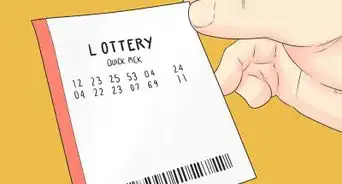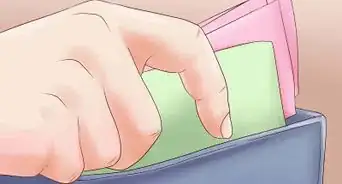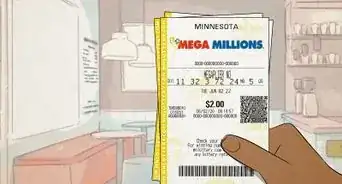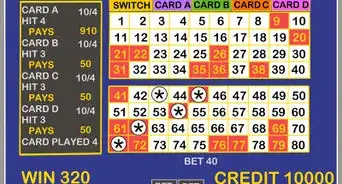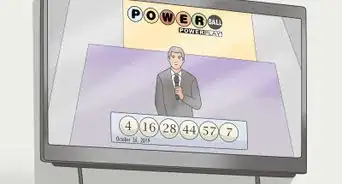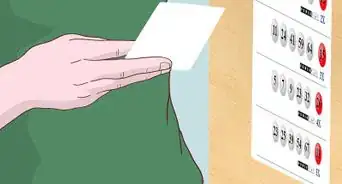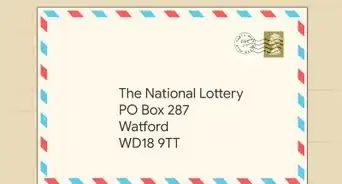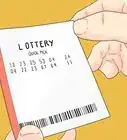wikiHow is a “wiki,” similar to Wikipedia, which means that many of our articles are co-written by multiple authors. To create this article, 62 people, some anonymous, worked to edit and improve it over time.
This article has been viewed 1,170,166 times.
Learn more...
Buying lottery tickets is easy, but since state-run lotteries in the USA typically pay out only half of their revenue to the winners, there's a house edge of about 50 percent. To boost your odds of winning on lottery tickets when choosing scratch-offs, try the singleton method, which relies on an understanding of the statistical quirks involved in attempts at randomizing numbers. To win on lottery tickets like the powerball game, you'll need to calculate the expected value of certain numbers before picking them. There's no sure way to consistently win on any lottery ticket, but there are some who swear by the legitimacy of these strategies when explaining their own good fortune.
Steps
Winning Scratch-Off Tickets
-
1Use the singleton method. A few years ago, a statistician discovered a statistical quirk in the production of scratch-off tickets, which can double your chances of winning if exploited correctly. Basically, scratch off games operate under the assumption of "randomness," but can't be produced in a truly random way, because the lottery board needs to keep track of how many winning tickets are in circulation.
-
2Buy the correct tickets. Some "match style" or "tic-tac-toe" scratch off tickets are marked with a kind of code you can learn to recognize. Look for the kind of ticket on which you must match "3 in a row" from a given group of amounts. Typically, the outside of the aluminum coating will be marked with seemingly "random" numbers you scratch off to reveal amounts on the inside. If, on a given ticket, game space, you get three $100 amounts, you win the amount listed.
- These are the games that can be deciphered using the singleton method. They're also typically among the cheapest lottery tickets, and have the lowest payouts, so you can buy several to practice.[1]
Advertisement -
3Chart the "random" outside numbers that repeat. Look at the numbers that mark the playing space and, for each, count how many times each number repeats on the ticket. Pay close attention to "singletons." These are the "random" numbers that appear only once on the ticket.
- The digits you're looking for won't be the same--that would mean they would appear more than once. Remember, you're looking for numbers that appear only once.
-
4Mark the ones. On a separate sheet of paper, draw a mock-up of the ticket, filling in "1" in place of the random digit in each space you find a singleton. A group of singletons will signal a winning card 60-90% of the time.
-
5Look for groupings. Depending on the rules of the game you're playing, you might need to look for three in a given space, or three in a row, but typically cards that display this abnormality are statistically more likely to be winners.
- 60% may not sound like a lot, but the average scratch-off card has a 30% chance of winning, so you've doubled your chances. Over a large group of tickets, this can yield a significant profit.
-
6Develop this technique. Experiment with other scratch off tickets looking for repetitions in the "random" numbers. All of them work on the same principle, and you might be able to discover an anomaly that you can exploit in a particular game. Buy cheap tickets and study them to see what you can come up with.
Winning Powerball Games
-
1Find the expected value. This is a good idea for any lottery game you are considering playing. The expected value refers to the probability of any one outcome, assuming all outcomes are equally probable. Here, the expected value calculates the value of the ticket, if the game was set up fairly so that the revenue gained from the losing tickets would match the winners' profits.
- In other words, this assumes the powerball lottery works like a fantasy football pool: five people throw in five bucks, the winner gets $25.
-
2Determine the probability of each possible "win." This will depend upon the specific powerball or number game you're playing. If it's a six-digit number that you pick, there are nine possibilities for each position and six different positions. Since each outcome is equally likely, you'll need to calculate a permutation. Alternatively, the odds should be listed in the game's rules.[2]
-
3Multiply the probability by the payout for that win. The probability will be a very small number that you'll add together to determine the expected value. Doing this will result in a negative value. In general, for each $2 you invest in powerball tickets, you can expect $.93 back.
- Account for any non-cash prizes by taking their cash value into account, and convert any annuities (annual distributions of prize money) into a lump sum for the purposes of this calculation.
-
4Buy tickets that increase the expected value. Specifically, a promotion that adds any percentage chance to the prize pool will make tickets a worthwhile purchase.
- One example of this was the Missouri Lottery's promotion in the daily Pick 3. Normally a player has a 1/1000 chance of winning a $600 prize, making a $1 ticket worth only $0.60. The promotion was to draw a second winning combination on one randomly selected day of the week. Originally, the drawing to determine whether the bonus would occur that day held six white balls and one orange, but on the last day of the week, all six white balls had been removed, leaving only the orange ball and ensuring a double drawing on the last day. [3] This doubled the value of tickets for that drawing and converted them from an expected 40 percent loss to a 20 percent gain. See table 1 below for how the expected value varied that week.
-
5Look for progressive jackpots. Larger jackpots increase the payouts and therefore the value of a ticket. The value of a large progressive jackpot is very sensitive to the exact rules of the game, so be sure to understand them.
- The Massachusetts lottery imposed purchase limits after it was discovered that their Cash Win-fail game had a positive expected value after a jackpot was rolled down to increase the payouts for lower level prizes.
- In the Mega Millions multi-state lottery, jackpots are split equally among all winners who match all numbers. If a player could ensure that he wouldn't have to split the jackpot, Mega Millions becomes a smart bet whenever the jackpot exceeds about $420 million, but this calculation doesn't account for the possibility of a split jackpot. It has been theorized that the ticket buying frenzies as the jackpot rises increases the likelihood of multiple winners sufficiently that the jackpot can never get large enough to give a ticket a positive expected value.[4]
-
6Consider the tax implications. In the United States, gambling winnings are taxable, but gambling losses are only deductible to offset winnings. This legal asymmetry may affect the math. The double draw promotion that resulted in a 20 percent player advantage before tax considerations is only profitable after taxes, provided the player can purchase the hundreds of tickets required to cover a significant fraction of the 1000 outcomes.
Community Q&A
-
QuestionHow do I pick a lottery number?
 Community AnswerPick random numbers or numbers that are significant to you. There are no ideal numbers to pick.
Community AnswerPick random numbers or numbers that are significant to you. There are no ideal numbers to pick. -
QuestionIs it better to buy 20 $1 tickets or two $10 tickets or one $20 ticket?
 Community AnswerI work at a store that sells Missouri Lottery. $1 scratchers have an 8-1 winning probability including a free ticket win, $10 tickets have around a 4-1 chance of winning including the $10 prize. The biggest win I've seen off a $1 ticket since I've worked there is $50. Most of the wins are free ticket wins. Once in awhile I see a $5 or $10 win.
Community AnswerI work at a store that sells Missouri Lottery. $1 scratchers have an 8-1 winning probability including a free ticket win, $10 tickets have around a 4-1 chance of winning including the $10 prize. The biggest win I've seen off a $1 ticket since I've worked there is $50. Most of the wins are free ticket wins. Once in awhile I see a $5 or $10 win. -
QuestionIs there ever a 100% chance of winning?
 Community AnswerNo, not that I know of. But, if there was one, you'd still not have a 100% chance of profiting because a prize can be smaller than the price of the ticket itself.
Community AnswerNo, not that I know of. But, if there was one, you'd still not have a 100% chance of profiting because a prize can be smaller than the price of the ticket itself.
Tables
| Day | White Balls | Orange Balls | Probability of second drawing | Expected profit/loss per ticket |
|---|---|---|---|---|
| Normal | N/A | N/A | 0 | -$0.40 |
| 1 | 6 | 1 | 0.143 | -$0.31 |
| 2 | 5 | 1 | 0.167 | -$0.30 |
| 3 | 4 | 1 | 0.200 | -$0.28 |
| 4 | 3 | 1 | 0.250 | -$0.25 |
| 5 | 2 | 1 | 0.333 | -$0.20 |
| 6 | 1 | 1 | 0.500 | -$0.10 |
| 7 | 0 | 1 | 1.000 | +$0.20 |
References
About This Article
To boost your chances of winning on scratch-off lottery tickets, buy tickets where you need to match 3 winning numbers in a row to win. While the winning numbers on these tickets are supposed to be random, they actually aren’t. Look at the numbers on the card and check how often they repeat. If you notice any “singleton” numbers that don’t repeat anywhere, draw a chart and mark where they appear on the card with a “1”. Look for any place on the card where 3 singletons are grouped together in a winning pattern (such as 3 in a row). If you see any of these groups of 3, there’s a 60-90% chance you have a winning card. To learn how to increase your chances of winning at powerball lottery games, read on!


